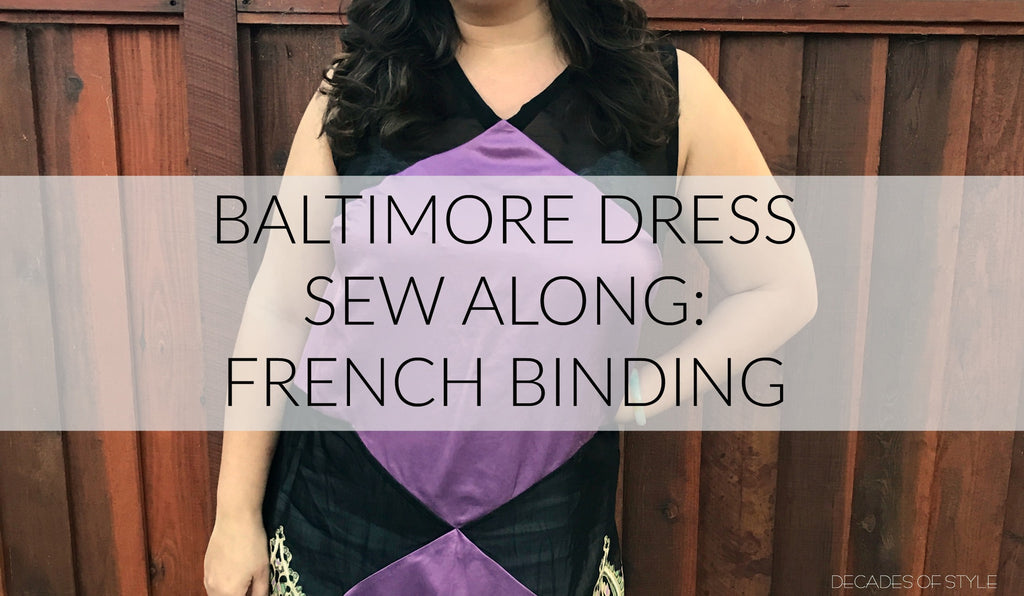News
Baltimore Dress Sew Along: French Binding February 13 2017
Sorry for the long wait in between blog posts. We worked really hard to release a trio of pattens at once and then promptly contracted the plague. Seriously, we all went down with a variety of ick from sinus infections to the flu. But at least it was possible to enjoy the enthusiastic response of all of you to our new patterns! We are grateful for all of the excitement shared by our customers and followers on our social media. It makes us anxious to get on to the next round! (1930s anyone?)
But first, let's finish with the Baltimore Dress.
Now that the bias seams are stabilized and the front part of the dress is sewn together, the rest of the dress is very straight forward starting with shoulder darts on the Dress Back. Sizes 30, 32, and 34, require a continuous neck placket. Sewaholic has a great tutorial on sewing a continuous neck placket to give you a detailed look at this process.
Next step is shoulder seams. We reinforced the shoulder seam with Design Plus stay tape just because our fabric was so lightweight and the shoulder seams can be stressed by the weight of the garment, and therefore pull.

We used French binding to finish the neck and armhole edges. Mais, qu'est que-ce? Most people use the the technique illustrated by Tilly and the Buttons, where the bias encompasses the raw edge and is visible on the finished garment. You can use this technique if you like; it is perfectly accurate to 1920s finishing options. You can use the same fabric or a contrasting fabric. Ultimately, we decided on French binding for finishing the edges because the binding is not visible on the finished garment and therefore has a "cleaner" look.
We like to make our own bias as it allows us to control the width and weight of it. The store bought stuff tends to be stiff (often a cotton/poly blend) and never seems to behave quite right. For this Baltimore Dress, instead of using the very lightweight silk/cotton fabric of the dress, we used a black cotton voile. It is lightweight enough to mold easily and yet stiff enough to act as a stabilizer. If you are using a loosely woven fabric, like a chiffon, make your bias at least 2"-2 1/4" wide as chiffon blooms quite a bit when on the bias. MADE EVERYDAY has a comprehensive tutorial to making your own bias. (She uses a bias maker, the tool you use to fold and press the bias tape, which we didn't use this time around.)
Once the bias tape is made, head to the ironing board with the dress and bias tape. The bias tape needs to be shaped to match the curve of the armscye.

Pre-shaping the bias keeps it from pulling, puckering and twisting through all the steps involved: stitching it to the dress: turning and pressing the binding to the inside and finally, hand sewing it into place.
HAND SEWING?! Yes. It is SOO worth the time and effort to up your couture sewing game and achieve a result that matches any authentic vintage garment out there. To sew the facing in place as invisibly as possible, use a running or whip stitch where you only grab 2-3 threads on the right side of the fabric and then take a medium to small stitch on the wrong side of the fabric.

The process of French binding is the same for finishing the neckline. If you want a detailed explanation on binding for garments, Victory Patterns has a great tutorial on the the two types of bias binding by machine.

We hemmed this particular skirt by hand. The Skirt Front Panel has some bias so hemming it by hand gives you the most control. We tested this pattern in a firmly woven lightweight shirting fabric and had great success using a rolled hem foot and hemming it on the machine. Stay-stitching the bias curves before putting it through the rolled hem was the key to getting a nice result.

The Baltimore Dress is so versatile, it can shift effortlessly from a serious 1920s themed event to daily wear with a simple change of accessories and hairstyle. We hoped you enjoyed our sew along and we can't wait to see what you make!

